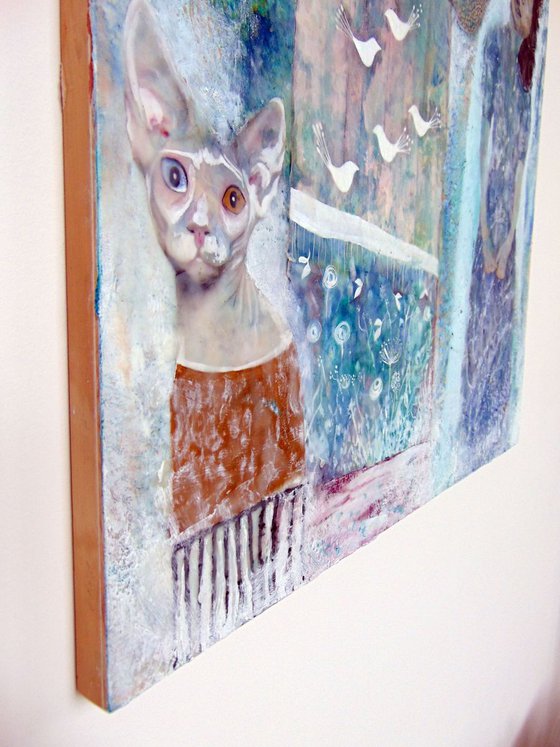- By medium
- By subject
- By budget
- Sales
- Gift cards
- Discover all art
- Artists
- Editors’ picks
- Ideas
Original artwork description:
I 've started to explore new technique called Encaustic painting, also known as hot wax painting.
Encaustic is a Greek word meaning “to heat or burn in” (enkaustikos). Heat is used throughout the process, from melting the beeswax and varnish to fusing the layers of wax. Encaustic consists of natural bees wax and dammar resin (crystallized tree sap). The medium can be used alone for its transparency or adhesive qualities or used pigmented. Pigments may be added to the medium, or purchased colored with traditional artist pigments. The medium is melted and applied with a brush or any tool the artist wishes to create from. Each layer is then reheated to fuse it to the previous layer.
The fluid nature of encaustic makes the medium particularly well suited to process - based abstraction.Encaustic can,however,also be manipulated to create dramatic three-dimensional effects,subtle atmospheric illusions,or realistic details.Its umique properties allow encaustic to appear molten or solid,translucent or opaque,smooth or textural,thick or thin,shiny or matte.It can be polished to an enamel-like luster or used with subtlety to create muted but luminous surfaces.It can also be modeled,sculpted,textured,or combined with collage materials.While it is relatively easy to achieve interesting results with encaustic,it is difficult to master the full range of its subtle effects and properties because encaustic does not allow the extended wet-into-wet mixing of traditional oil painting.Because molten wax hardens rapidly once the heat source is removed,ilusions and images must be crafted one stroke and one layer at a time.Artists working in encaustic therefore employ various additive and subtractive techniques-fusing,scraping,casting,pouring,inscribing,stenciling,dipping,and burnishing - to fabricate a painterly or sculptural surface.
Encaustic is a hand-on,labor-intensive process that combines materiality,metaphor,and mystery.I suspect that,for some,the ritualistic process of encaustic provides an antidote to our techno-media driven culture; for others,it generates a respite for comntemplative mind.
For me,encautic resonates with sensual materiality.The aromatic scent of honeyed beeswax is an intoxicating perfume.Tactile surfaces reveal or conceal unique traces of the artist's hand,while encaustic's gleaming colours and complex image layers orchestrate finely tuned compositions.The medium is compelling option for contemporary artists,one that,when handled correctly,is capable of producing physical and ethereal results.Encaustic's luminosity,unpredictability,and transformative ability to convey mystery are all compelling reasons to work with wax...
Materials used:
wooden panel,,japanese rice paper,,colour pencils,,beeswax,,ink,,oilbar,,varnish
Tags:
#blue #nature #green #white #people #birds #turquoise #cat #plants #dream #natural #girls #wings #tranquility #dreamlike #encaustic #wax #dusty roseNATURE IS MY HOME (2017) Painting
by Ivana Pavlikova
4 Artist Reviews
£2,000
- Painting on Panel / Board / MDF
- One of a kind artwork
- Size: 61 x 91 x 2cm (unframed) / 61 x 91cm (actual image size)
- Ready to hang
- Signed on the back
- Style: Organic
- Subject: People and portraits
Loading
Original artwork description
I 've started to explore new technique called Encaustic painting, also known as hot wax painting.
Encaustic is a Greek word meaning “to heat or burn in” (enkaustikos). Heat is used throughout the process, from melting the beeswax and varnish to fusing the layers of wax. Encaustic consists of natural bees wax and dammar resin (crystallized tree sap). The medium can be used alone for its transparency or adhesive qualities or used pigmented. Pigments may be added to the medium, or purchased colored with traditional artist pigments. The medium is melted and applied with a brush or any tool the artist wishes to create from. Each layer is then reheated to fuse it to the previous layer.
The fluid nature of encaustic makes the medium particularly well suited to process - based abstraction.Encaustic can,however,also be manipulated to create dramatic three-dimensional effects,subtle atmospheric illusions,or realistic details.Its umique properties allow encaustic to appear molten or solid,translucent or opaque,smooth or textural,thick or thin,shiny or matte.It can be polished to an enamel-like luster or used with subtlety to create muted but luminous surfaces.It can also be modeled,sculpted,textured,or combined with collage materials.While it is relatively easy to achieve interesting results with encaustic,it is difficult to master the full range of its subtle effects and properties because encaustic does not allow the extended wet-into-wet mixing of traditional oil painting.Because molten wax hardens rapidly once the heat source is removed,ilusions and images must be crafted one stroke and one layer at a time.Artists working in encaustic therefore employ various additive and subtractive techniques-fusing,scraping,casting,pouring,inscribing,stenciling,dipping,and burnishing - to fabricate a painterly or sculptural surface.
Encaustic is a hand-on,labor-intensive process that combines materiality,metaphor,and mystery.I suspect that,for some,the ritualistic process of encaustic provides an antidote to our techno-media driven culture; for others,it generates a respite for comntemplative mind.
For me,encautic resonates with sensual materiality.The aromatic scent of honeyed beeswax is an intoxicating perfume.Tactile surfaces reveal or conceal unique traces of the artist's hand,while encaustic's gleaming colours and complex image layers orchestrate finely tuned compositions.The medium is compelling option for contemporary artists,one that,when handled correctly,is capable of producing physical and ethereal results.Encaustic's luminosity,unpredictability,and transformative ability to convey mystery are all compelling reasons to work with wax...
Materials used:
wooden panel,,japanese rice paper,,colour pencils,,beeswax,,ink,,oilbar,,varnish
Tags:
#blue #nature #green #white #people #birds #turquoise #cat #plants #dream #natural #girls #wings #tranquility #dreamlike #encaustic #wax #dusty rose14 day money back guaranteeLearn more
















